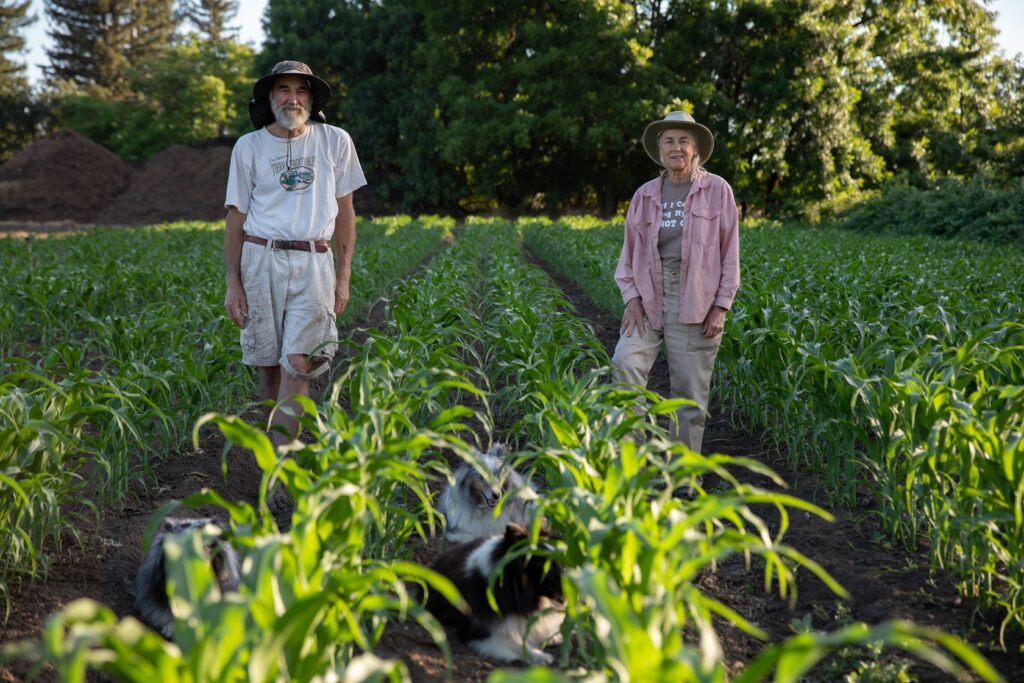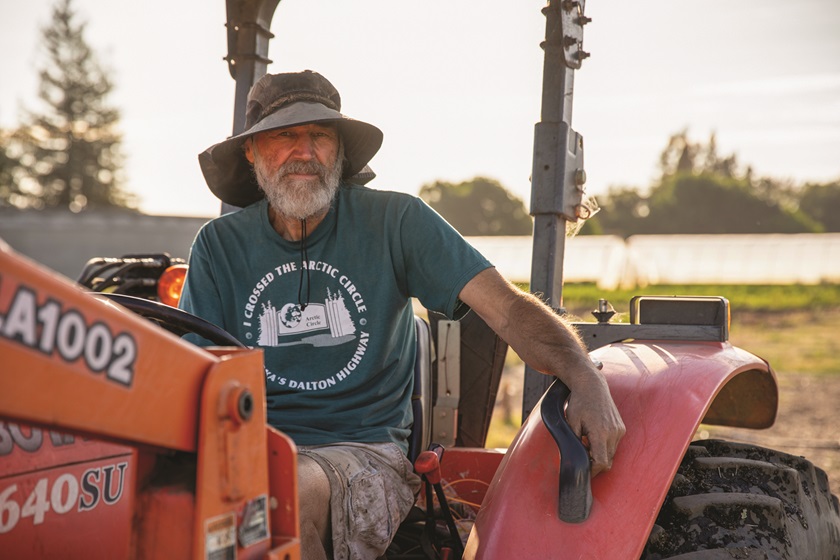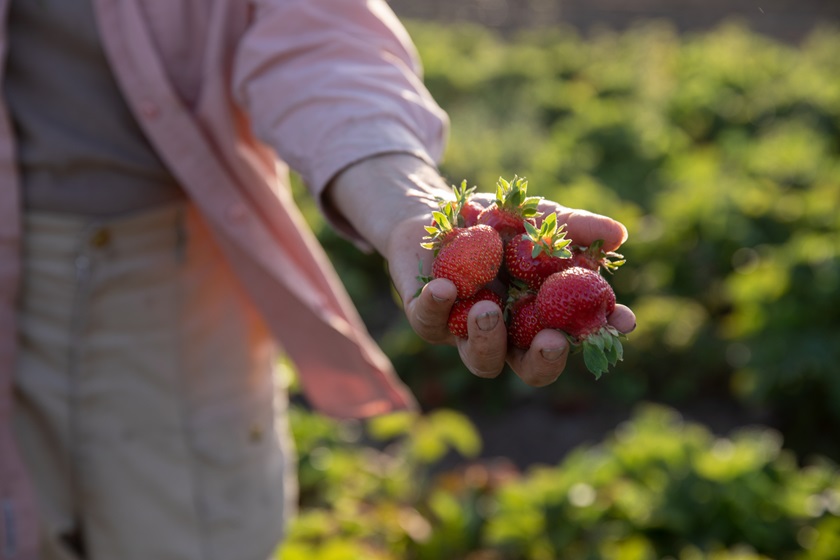SEE PART 1 IN VOL. 11 – ISSUE 2 – MAR/APR
The Future of Farming, Part 2
Can We Make Farmland Conservation Work When Farmers Don’t Own The Land?
PHOTOS BY PAIGE GREEN
Twenty years ago Wayne James harvested garlic with a pickaxe. Today, on the exact same plot of land, all that’s required is a light tug and those bulbs slide right out from soft, dark earth. That’s because Wayne, together with his sister Lee, have spent the past two decades rotating crops, applying compost, and cultivating soil that’s now rich with life. That investment in the land—together with installing irrigation, erecting a barn, and growing a loyal customer base—has paid off in the form of one of Sonoma County’s best-known farms: Tierra Vegetables.
The only problem: all those investments sit atop land they don’t own.
Wayne and Lee James aren’t the only tenant farmers around these parts. But what sets them apart is who owns the property they farm: Sonoma County Agriculture + Open Space (AOS), the government agency tasked with “preserving agricultural lands as a legacy for future generations.” That’s because AOS typically isn’t in the business of owning and leasing out land to tenants. Rather, they almost exclusively work with landowners. When there’s pressure to develop or subdivide a parcel, AOS steps in, offering to purchase the rights to develop that land, paying the owner, and preventing suburban sprawl.
So why did they work with Wayne and Lee? It would seem they were just a fluke. But one that might just point towards a solution to getting more new farmers on the land.
In the late 1990s, when a parcel came up for sale along Highway 101 north of Santa Rosa, AOS took the unusual step of purchasing it outright and in 2002 began leasing it to the James siblings. For the next two decades, while property values nearby nearly tripled, AOS kept Lee and Wayne’s lease at a reasonable rate with little fear of eviction. Wayne isn’t blind to their luck. “It’s why we’ve been able to do what we’ve done,” he says, “why I’ve been able to take the risks that I have.”
But no farmer since then has been so lucky. And today, not only is AOS more averse to owning and leasing out land than ever before, they’re now hoping to sell off the few parcels they do own, including Lee and Wayne’s. The true purpose of AOS, they say, is holding rights, not the land itself.
So to save Tierra Vegetabless, the James’ might need to buy the land. But can they? All his life Wayne’s worked in agriculture, starting back in 1976 when he took a job as a farmhand growing melons and corn up in Potter Valley, making 30 bucks a day, living in a trailer on his family’s property. Today he might own his own business, but without the land, will it be enough?
None of this, of course, would matter if growing food was more lucrative, if consumers paid its true cost, allowing farmers to save up for a down payment. But the truth is: purchasing land in Sonoma County using only the proceeds of farming is almost impossible today. Be it the prevailing wage for farm work or the profit margin on a carrot, the math just doesn’t add up. Even beyond Sonoma, according to the latest Census of Agriculture, the vast majority of American farms rely on off-farm income to make ends meet.
Wayne and Lee don’t have off-farm income. Or an inheritance. And yet, unlike most tenant farmers, they’ve still managed not only to invest in their business but also to put away some money. How?
Because of that fluke, the subsidized lease from AOS allowed them, over the course of decades, to save what would otherwise have been sunk into ever-increasing rent payments. And its stability gave them the confidence to invest, for instance, in improving the soil or in that barn, something most tenants wouldn’t dare do.
But will Wayne and Lee be able to compete in the cutthroat real estate market of 2024? With the help of a new pilot project called Buy-Protect-Sell, they might.
The idea is: instead of exclusively working with landowners, AOS would purchase a property like the one the James’ farm and remove its development rights, thereby decreasing its value, and then sell it to them at a lower cost. If all goes according to plan, Wayne and Lee might just be the guinea pigs for a new effort aimed at giving newer farmers a chance at land security.
But their nest egg was only possible because of this unique lease. Had it not been for that initial fluke, would they be in a position today to consider even the lowered price tag of a Buy-Protect-Sell deal? Would they even still be farming? Or would they have thrown in the towel like so many other farmers holding on to the idealistic belief that you can build a livelihood by simply growing and selling food without land ownership, an outside income, or an inheritance? Buy-Protect-Sell will certainly help, but to get new farmers into a place where they too can take advantage of that program, we’ll need to find a way to replicate that fluke too, the unique terms of their lease—something AOS is reluctant to do. Their job, they remind us, is to hold rights, not land.
But if not them, says Wayne, someone needs to do it. Unless, that is, we want a future in which only the independently wealthy can farm. Then again, Wayne doesn’t think the job of leasing out land should fall to a government agency anyway, wary of red tape and the glacial pace of bureaucracy. Instead, his dream is that his own fluke could be replicated by a nonprofit organization tasked with holding and leasing land to farmers with security and affordability baked in. AOS would buy the land, protect the land, then sell it to that organization at a lower cost, but the organization would be tasked with managing the leases. The farmers, meanwhile, less burdened by the ever-rising cost of land and secure enough to invest in their business without fear of eviction, could not only make ends meet but might even be able to put away some money for a down payment—or even retirement.
No longer a young, scrappy upstart, Wayne, along with his sister Lee, is not only seeking a future for Tierra Vegetables, they’re also thinking about life after farming. With the prospect of land ownership on his mind, one thing’s become clear to Wayne, “When you look at land as an investment, it just doesn’t work out for the next generation.”
For the past century, the retirement plan of many local farmers was to just sell off a bit of their land—sometimes to another farmer but often to a developer. This slicing and dicing, of course, can only happen so many times before farmland gets replaced by suburbia. And it was this concern that led to the creation of AOS in the first place. Land-owning farmers can now sell their development rights instead of their land. But they can only be sold once. If mom and dad sell those rights to fund their own retirement or to settle the estate, what’s left to fund yours? Or your kids’? The question is even tricker in the case of the James siblings and Buy-Protect-Sell, in which the rights will have already been sold off before they even get the land.
While neither Wayne nor Lee have kids of their own, they want their farm to live on, hoping a younger farmer can have the opportunity they have now. But in so doing, Wayne and Lee are asking an almost impossible question: how can they, in an industry where the land—not the farming—is the only thing valuable enough to fund retirement, pass on Tierra Vegetables to a new farmer in a way that in a way that both allows for them to make ends meet and fund their retirement?
Sustainable agriculture is typically understood in terms of sustaining the land. But if we’re going to truly “preserve agricultural lands as a legacy for future generations,” we’ll also need to sustain the farmers themselves, from their earliest days to their golden years, and until they too are returned to the earth.
tierravegetables.com | 707-544-6141
Tierra Vegetables Farmstand
651 Airport Boulevard Windsor
Open Year-Round, Thursday-Friday 10am-6pm
Saturday: 10am-5pm





